HISTORY OF ECONOMIC THOUGHT Structure of the course

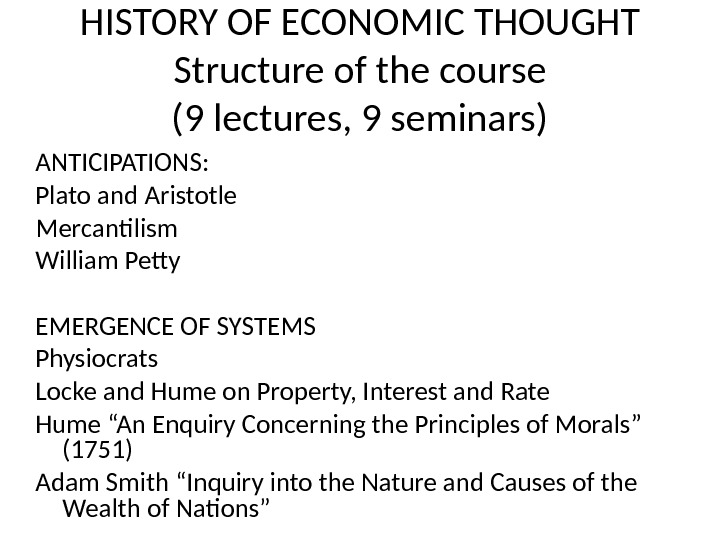
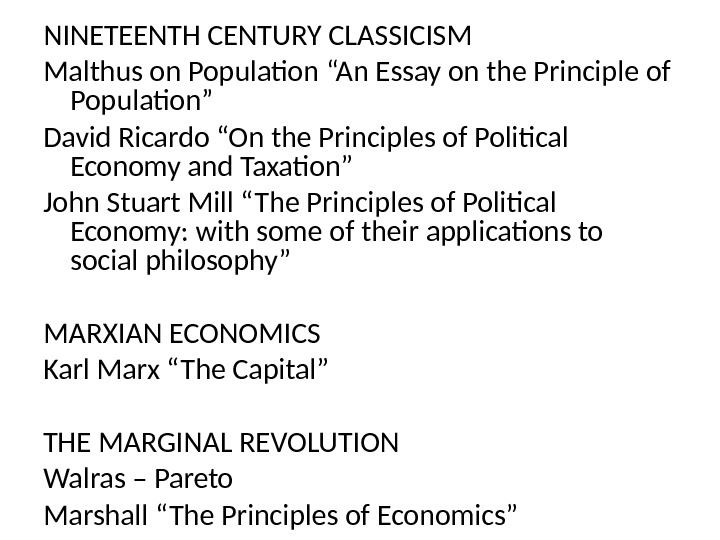
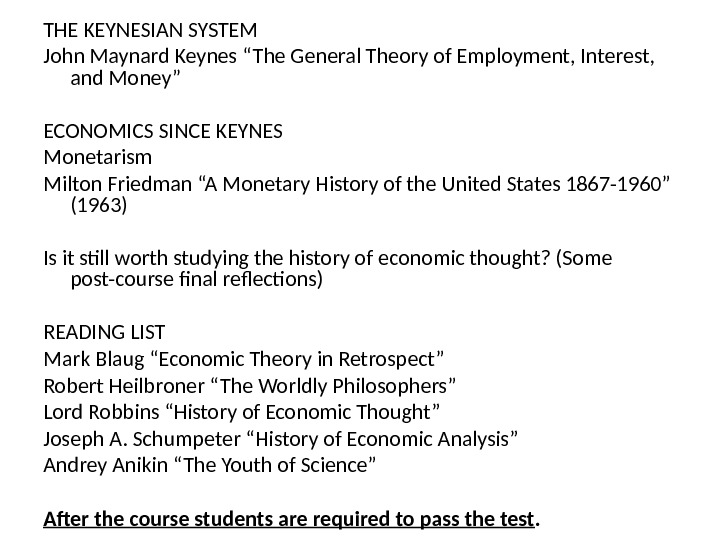
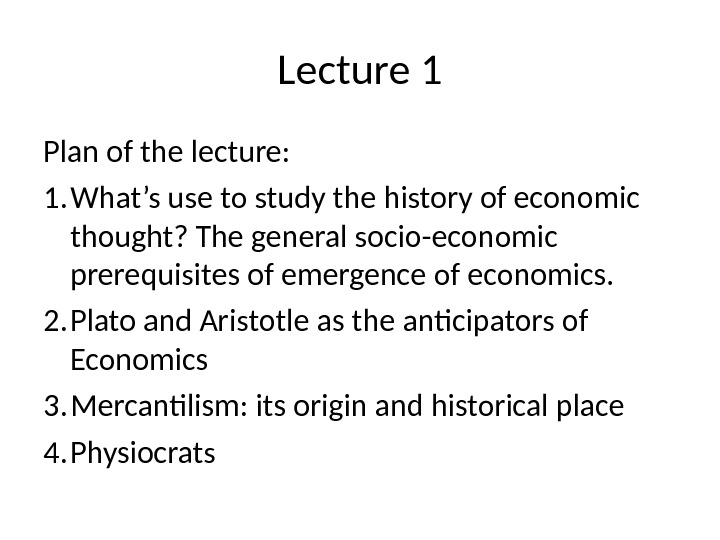
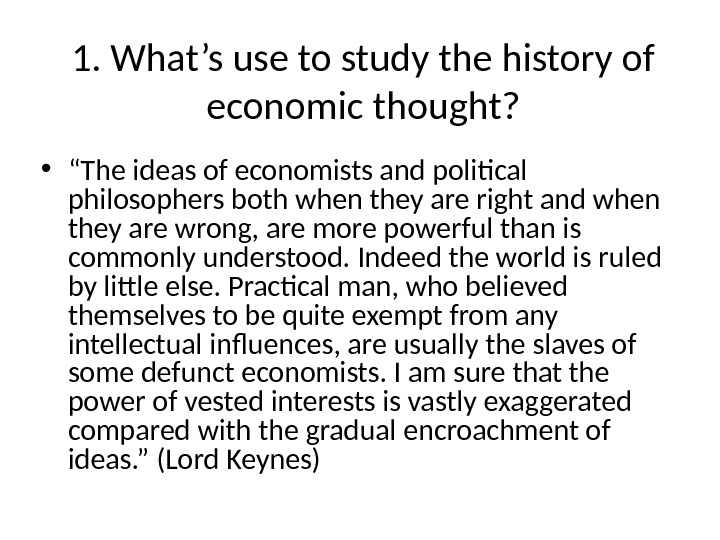
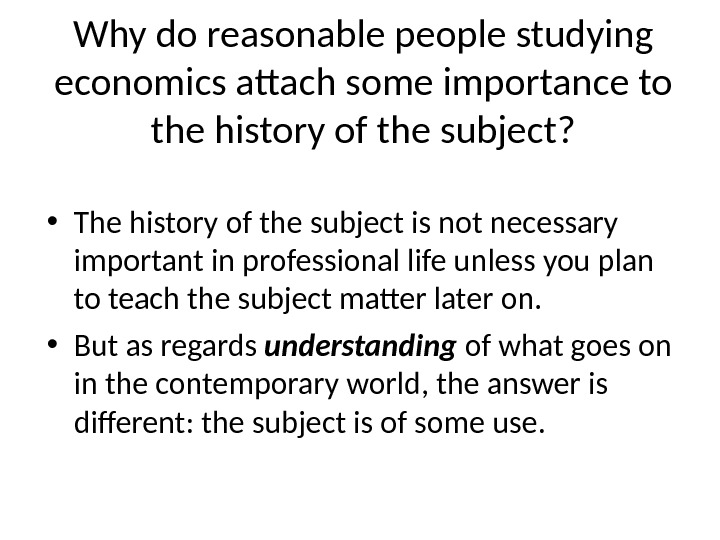
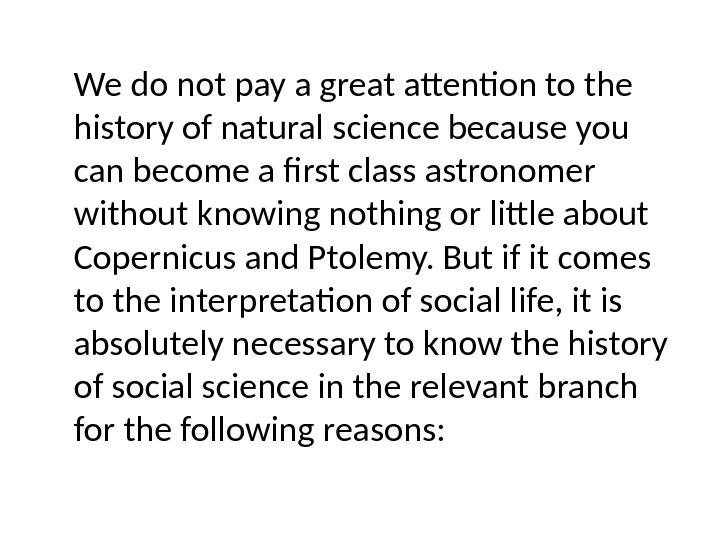
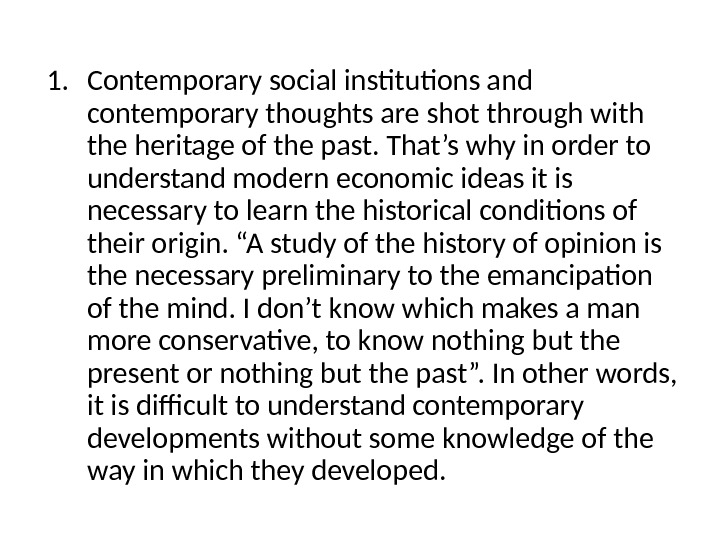
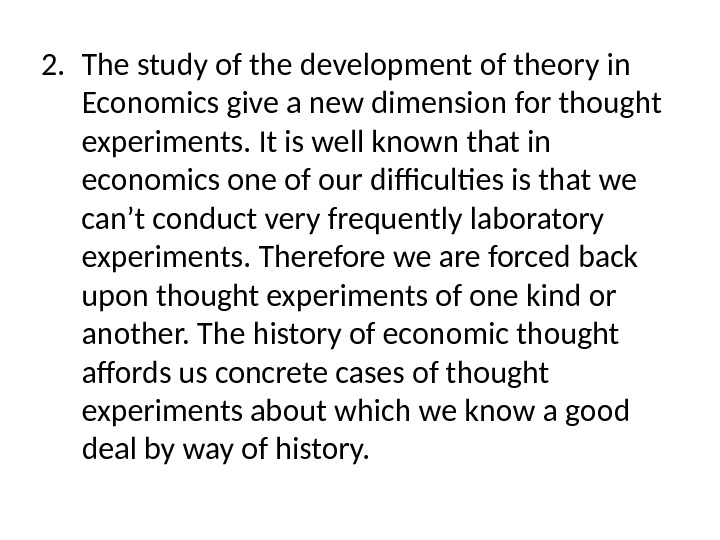
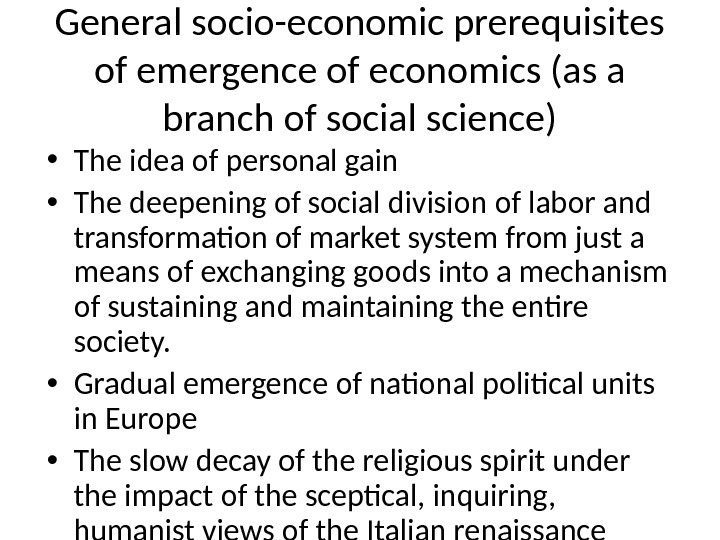
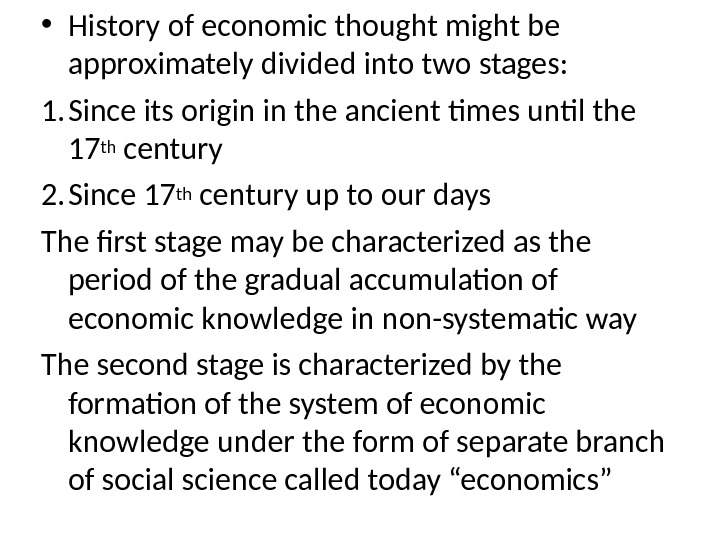
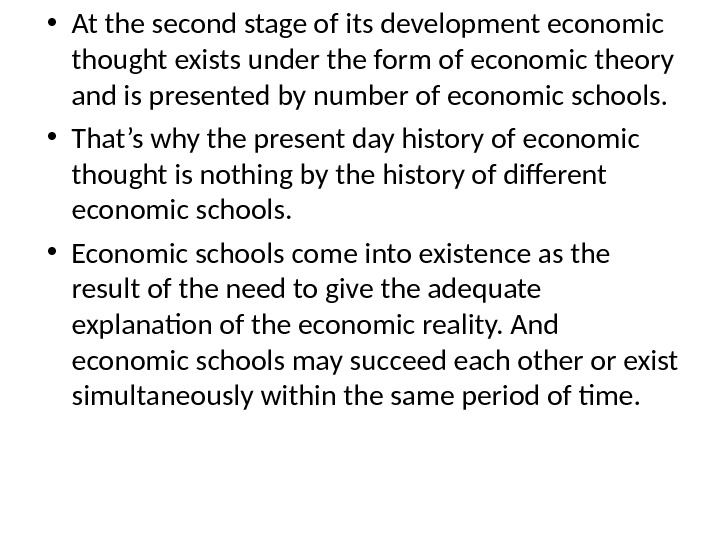
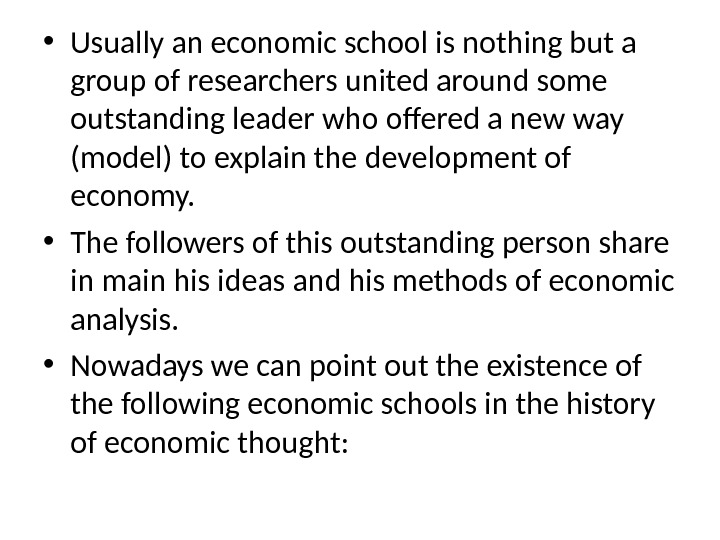
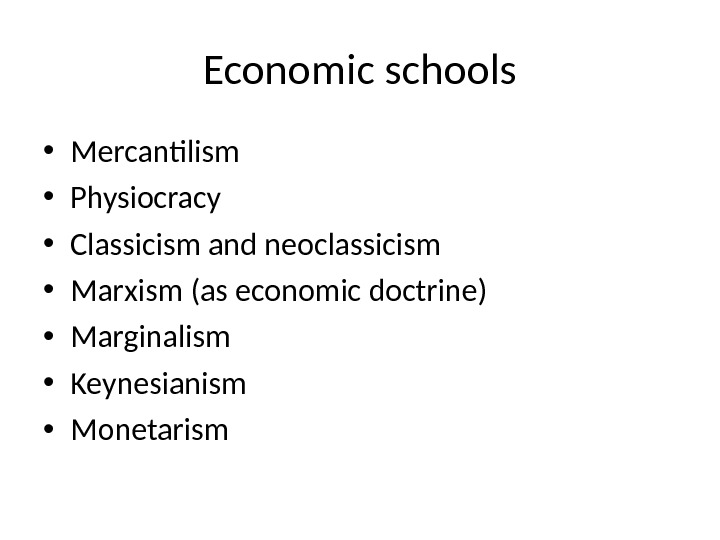
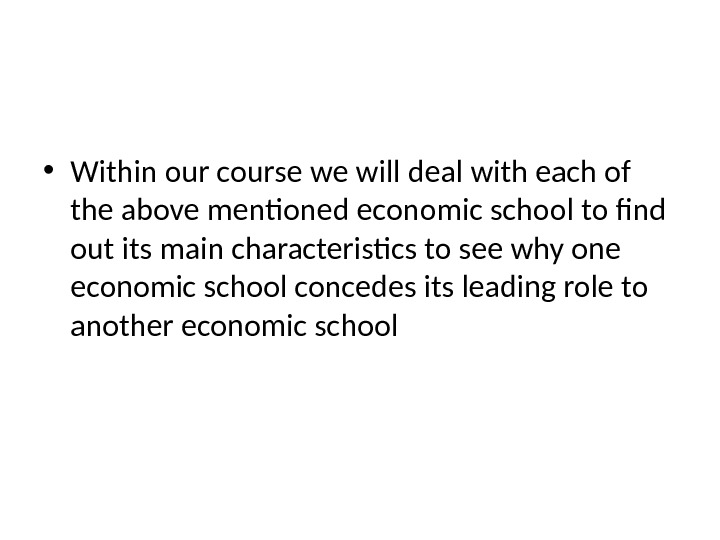
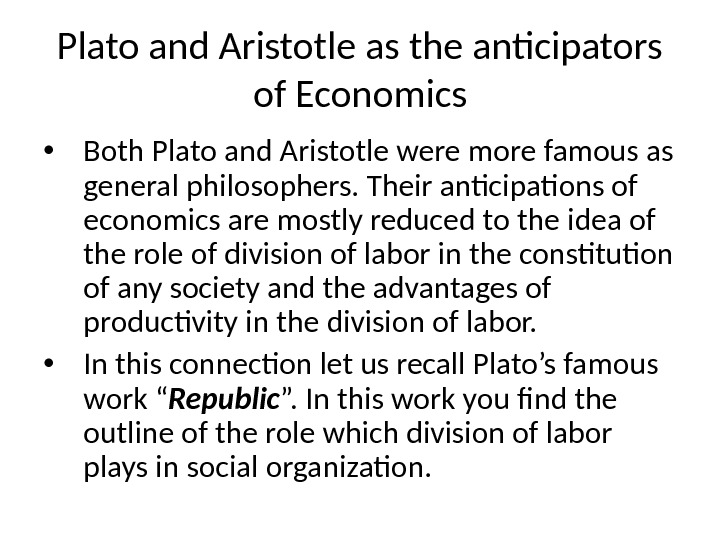
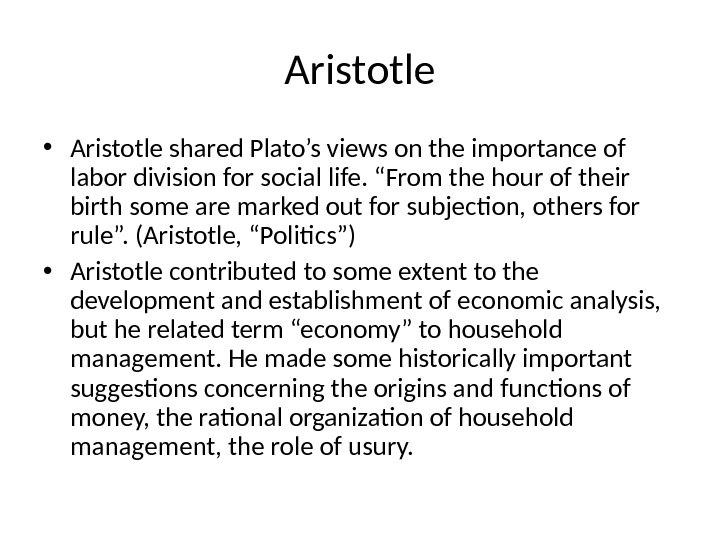
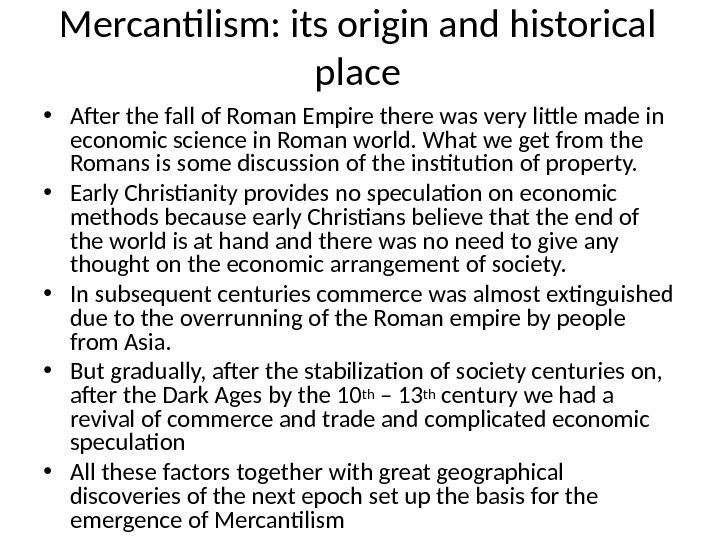
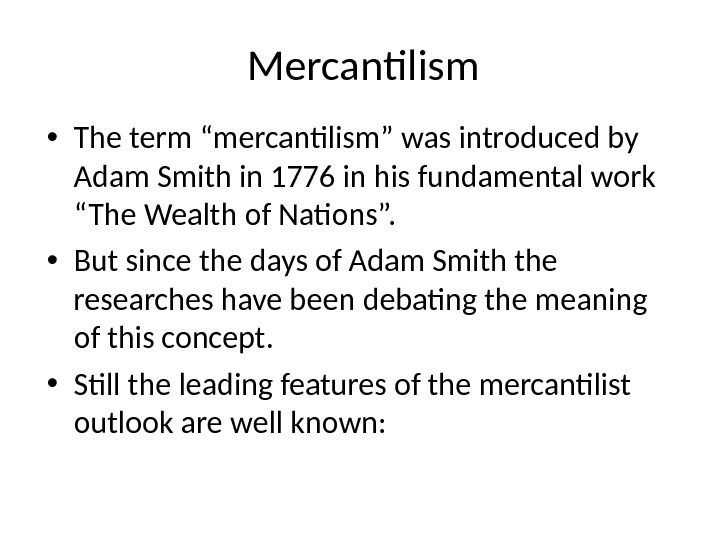
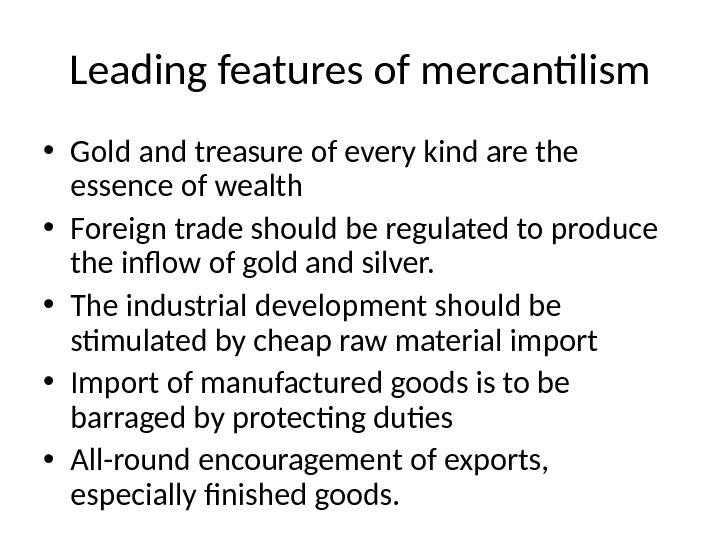
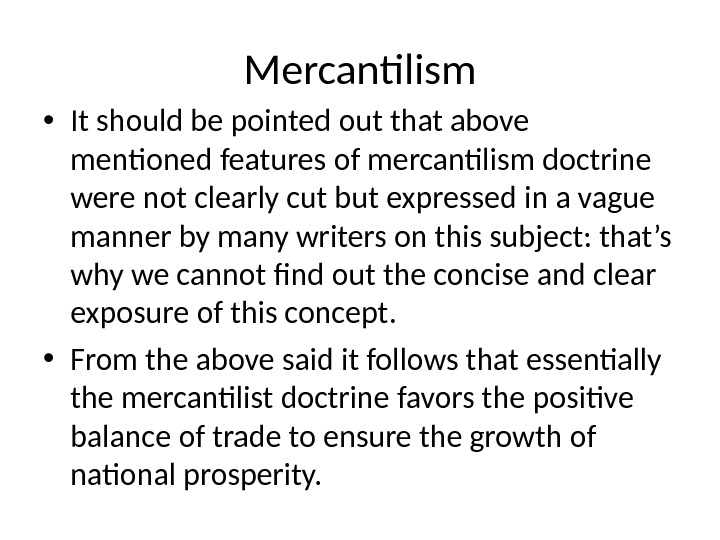
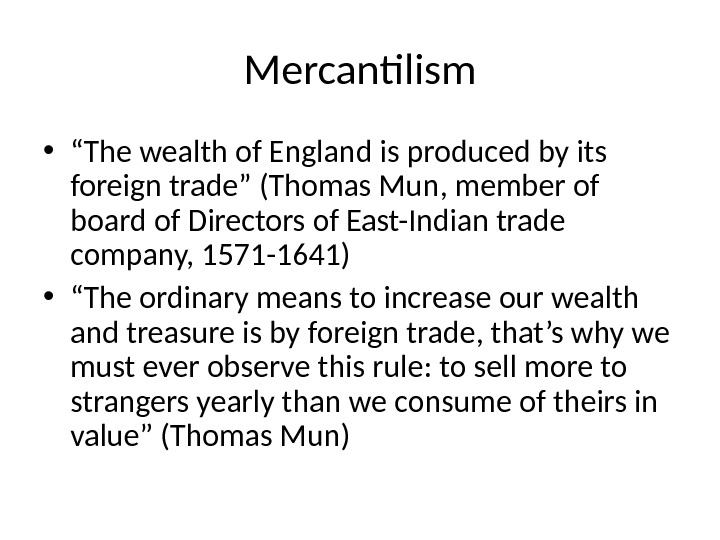
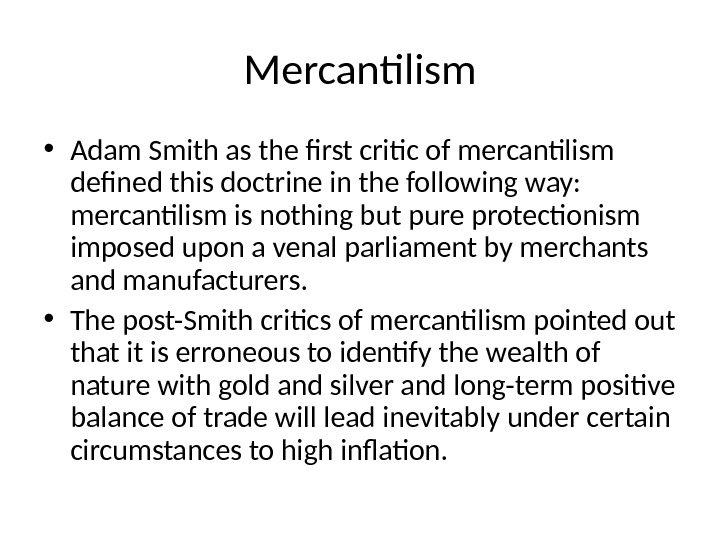
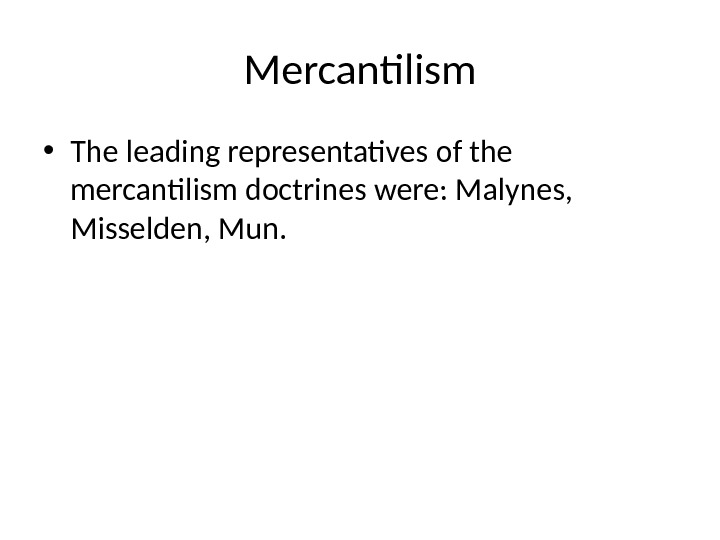

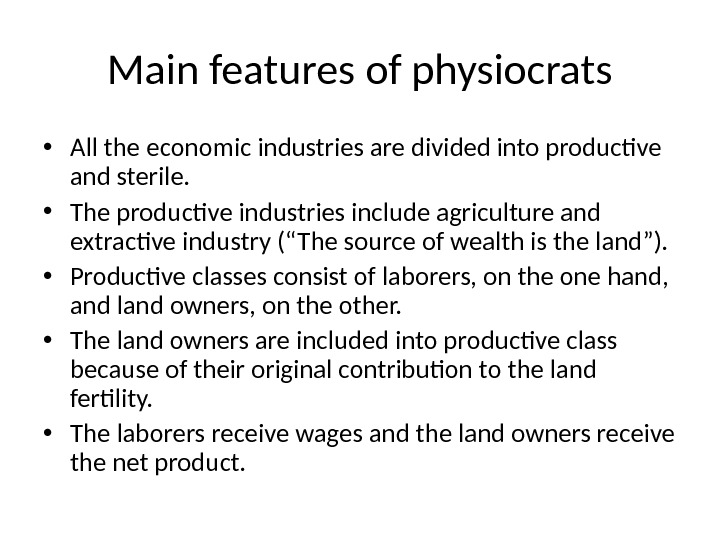
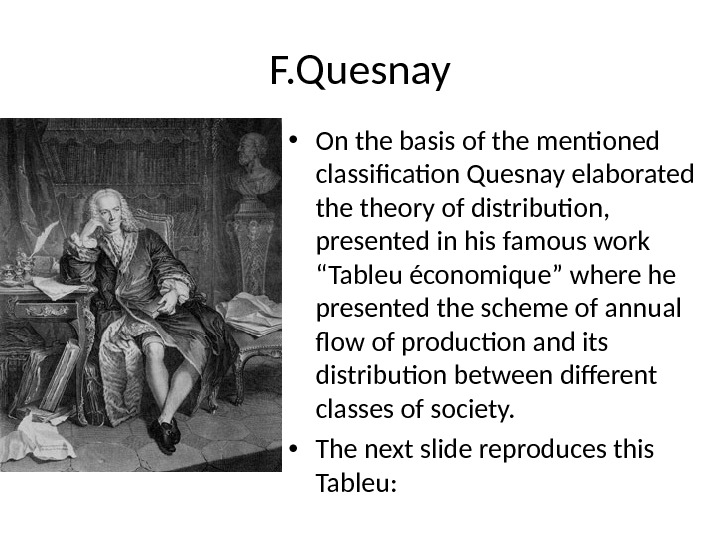
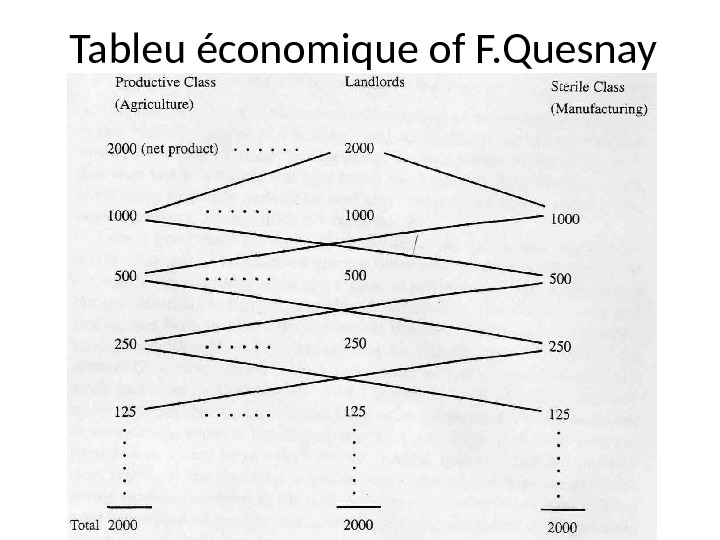
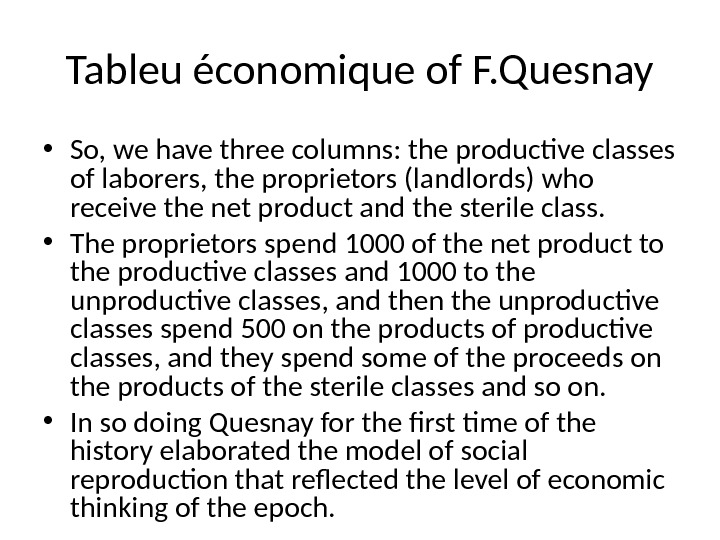
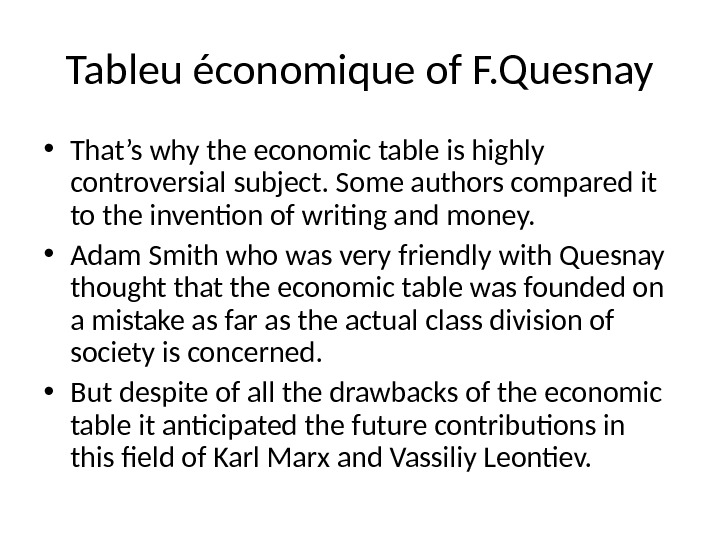
history_of_economic_thought._lecture_1.ppt
- Размер: 610 Кб
- Количество слайдов: 30
Описание презентации HISTORY OF ECONOMIC THOUGHT Structure of the course по слайдам
 HISTORY OF ECONOMIC THOUGHT Structure of the course (9 lectures, 9 seminars) ANTICIPATIONS: Plato and Aristotle Mercantilism William Petty EMERGENCE OF SYSTEMS Physiocrats Locke and Hume on Property, Interest and Rate Hume “An Enquiry Concerning the Principles of Morals” (1751) Adam Smith “Inquiry into the Nature and Causes of the Wealth of Nations”
HISTORY OF ECONOMIC THOUGHT Structure of the course (9 lectures, 9 seminars) ANTICIPATIONS: Plato and Aristotle Mercantilism William Petty EMERGENCE OF SYSTEMS Physiocrats Locke and Hume on Property, Interest and Rate Hume “An Enquiry Concerning the Principles of Morals” (1751) Adam Smith “Inquiry into the Nature and Causes of the Wealth of Nations”
 NINETEENTH CENTURY CLASSICISM Malthus on Population “An Essay on the Principle of Population” David Ricardo “On the Principles of Political Economy and Taxation” John Stuart Mill “The Principles of Political Economy: with some of their applications to social philosophy” MARXIAN ECONOMICS Karl Marx “The Capital” THE MARGINAL REVOLUTION Walras – Pareto Marshall “The Principles of Economics”
NINETEENTH CENTURY CLASSICISM Malthus on Population “An Essay on the Principle of Population” David Ricardo “On the Principles of Political Economy and Taxation” John Stuart Mill “The Principles of Political Economy: with some of their applications to social philosophy” MARXIAN ECONOMICS Karl Marx “The Capital” THE MARGINAL REVOLUTION Walras – Pareto Marshall “The Principles of Economics”
 THE KEYNESIAN SYSTEM John Maynard Keynes “The General Theory of Employment, Interest, and Money” ECONOMICS SINCE KEYNES Monetarism Milton Friedman “A Monetary History of the United States 1867 -1960” (1963) Is it still worth studying the history of economic thought? (Some post-course final reflections) READING LIST Mark Blaug “Economic Theory in Retrospect” Robert Heilbroner “The Worldly Philosophers” Lord Robbins “History of Economic Thought” Joseph A. Schumpeter “History of Economic Analysis” Andrey Anikin “The Youth of Science” After the course students are required to pass the test.
THE KEYNESIAN SYSTEM John Maynard Keynes “The General Theory of Employment, Interest, and Money” ECONOMICS SINCE KEYNES Monetarism Milton Friedman “A Monetary History of the United States 1867 -1960” (1963) Is it still worth studying the history of economic thought? (Some post-course final reflections) READING LIST Mark Blaug “Economic Theory in Retrospect” Robert Heilbroner “The Worldly Philosophers” Lord Robbins “History of Economic Thought” Joseph A. Schumpeter “History of Economic Analysis” Andrey Anikin “The Youth of Science” After the course students are required to pass the test.
 Lecture 1 Plan of the lecture: 1. What’s use to study the history of economic thought? The general socio-economic prerequisites of emergence of economics. 2. Plato and Aristotle as the anticipators of Economics 3. Mercantilism: its origin and historical place 4. Physiocrats
Lecture 1 Plan of the lecture: 1. What’s use to study the history of economic thought? The general socio-economic prerequisites of emergence of economics. 2. Plato and Aristotle as the anticipators of Economics 3. Mercantilism: its origin and historical place 4. Physiocrats
 1. What’s use to study the history of economic thought? • “ The ideas of economists and political philosophers both when they are right and when they are wrong, are more powerful than is commonly understood. Indeed the world is ruled by little else. Practical man, who believed themselves to be quite exempt from any intellectual influences, are usually the slaves of some defunct economists. I am sure that the power of vested interests is vastly exaggerated compared with the gradual encroachment of ideas. ” (Lord Keynes)
1. What’s use to study the history of economic thought? • “ The ideas of economists and political philosophers both when they are right and when they are wrong, are more powerful than is commonly understood. Indeed the world is ruled by little else. Practical man, who believed themselves to be quite exempt from any intellectual influences, are usually the slaves of some defunct economists. I am sure that the power of vested interests is vastly exaggerated compared with the gradual encroachment of ideas. ” (Lord Keynes)
 Why do reasonable people studying economics attach some importance to the history of the subject? • The history of the subject is not necessary important in professional life unless you plan to teach the subject matter later on. • But as regards understanding of what goes on in the contemporary world, the answer is different: the subject is of some use.
Why do reasonable people studying economics attach some importance to the history of the subject? • The history of the subject is not necessary important in professional life unless you plan to teach the subject matter later on. • But as regards understanding of what goes on in the contemporary world, the answer is different: the subject is of some use.
 We do not pay a great attention to the history of natural science because you can become a first class astronomer without knowing nothing or little about Copernicus and Ptolemy. But if it comes to the interpretation of social life, it is absolutely necessary to know the history of social science in the relevant branch for the following reasons:
We do not pay a great attention to the history of natural science because you can become a first class astronomer without knowing nothing or little about Copernicus and Ptolemy. But if it comes to the interpretation of social life, it is absolutely necessary to know the history of social science in the relevant branch for the following reasons:
 1. Contemporary social institutions and contemporary thoughts are shot through with the heritage of the past. That’s why in order to understand modern economic ideas it is necessary to learn the historical conditions of their origin. “A study of the history of opinion is the necessary preliminary to the emancipation of the mind. I don’t know which makes a man more conservative, to know nothing but the present or nothing but the past”. In other words, it is difficult to understand contemporary developments without some knowledge of the way in which they developed.
1. Contemporary social institutions and contemporary thoughts are shot through with the heritage of the past. That’s why in order to understand modern economic ideas it is necessary to learn the historical conditions of their origin. “A study of the history of opinion is the necessary preliminary to the emancipation of the mind. I don’t know which makes a man more conservative, to know nothing but the present or nothing but the past”. In other words, it is difficult to understand contemporary developments without some knowledge of the way in which they developed.
 2. The study of the development of theory in Economics give a new dimension for thought experiments. It is well known that in economics one of our difficulties is that we can’t conduct very frequently laboratory experiments. Therefore we are forced back upon thought experiments of one kind or another. The history of economic thought affords us concrete cases of thought experiments about which we know a good deal by way of history.
2. The study of the development of theory in Economics give a new dimension for thought experiments. It is well known that in economics one of our difficulties is that we can’t conduct very frequently laboratory experiments. Therefore we are forced back upon thought experiments of one kind or another. The history of economic thought affords us concrete cases of thought experiments about which we know a good deal by way of history.
 General socio-economic prerequisites of emergence of economics (as a branch of social science) • The idea of personal gain • The deepening of social division of labor and transformation of market system from just a means of exchanging goods into a mechanism of sustaining and maintaining the entire society. • Gradual emergence of national political units in Europe • The slow decay of the religious spirit under the impact of the sceptical, inquiring, humanist views of the Italian renaissance
General socio-economic prerequisites of emergence of economics (as a branch of social science) • The idea of personal gain • The deepening of social division of labor and transformation of market system from just a means of exchanging goods into a mechanism of sustaining and maintaining the entire society. • Gradual emergence of national political units in Europe • The slow decay of the religious spirit under the impact of the sceptical, inquiring, humanist views of the Italian renaissance
 • History of economic thought might be approximately divided into two stages: 1. Since its origin in the ancient times until the 17 th century 2. Since 17 th century up to our days The first stage may be characterized as the period of the gradual accumulation of economic knowledge in non-systematic way The second stage is characterized by the formation of the system of economic knowledge under the form of separate branch of social science called today “economics”
• History of economic thought might be approximately divided into two stages: 1. Since its origin in the ancient times until the 17 th century 2. Since 17 th century up to our days The first stage may be characterized as the period of the gradual accumulation of economic knowledge in non-systematic way The second stage is characterized by the formation of the system of economic knowledge under the form of separate branch of social science called today “economics”
 • At the second stage of its development economic thought exists under the form of economic theory and is presented by number of economic schools. • That’s why the present day history of economic thought is nothing by the history of different economic schools. • Economic schools come into existence as the result of the need to give the adequate explanation of the economic reality. And economic schools may succeed each other or exist simultaneously within the same period of time.
• At the second stage of its development economic thought exists under the form of economic theory and is presented by number of economic schools. • That’s why the present day history of economic thought is nothing by the history of different economic schools. • Economic schools come into existence as the result of the need to give the adequate explanation of the economic reality. And economic schools may succeed each other or exist simultaneously within the same period of time.
 • Usually an economic school is nothing but a group of researchers united around some outstanding leader who offered a new way (model) to explain the development of economy. • The followers of this outstanding person share in main his ideas and his methods of economic analysis. • Nowadays we can point out the existence of the following economic schools in the history of economic thought:
• Usually an economic school is nothing but a group of researchers united around some outstanding leader who offered a new way (model) to explain the development of economy. • The followers of this outstanding person share in main his ideas and his methods of economic analysis. • Nowadays we can point out the existence of the following economic schools in the history of economic thought:
 Economic schools • Mercantilism • Physiocracy • Classicism and neoclassicism • Marxism (as economic doctrine) • Marginalism • Keynesianism • Monetarism
Economic schools • Mercantilism • Physiocracy • Classicism and neoclassicism • Marxism (as economic doctrine) • Marginalism • Keynesianism • Monetarism
 • Within our course we will deal with each of the above mentioned economic school to find out its main characteristics to see why one economic school concedes its leading role to another economic school
• Within our course we will deal with each of the above mentioned economic school to find out its main characteristics to see why one economic school concedes its leading role to another economic school
 Plato and Aristotle as the anticipators of Economics • Both Plato and Aristotle were more famous as general philosophers. Their anticipations of economics are mostly reduced to the idea of the role of division of labor in the constitution of any society and the advantages of productivity in the division of labor. • In this connection let us recall Plato’s famous work “ Republic ”. In this work you find the outline of the role which division of labor plays in social organization.
Plato and Aristotle as the anticipators of Economics • Both Plato and Aristotle were more famous as general philosophers. Their anticipations of economics are mostly reduced to the idea of the role of division of labor in the constitution of any society and the advantages of productivity in the division of labor. • In this connection let us recall Plato’s famous work “ Republic ”. In this work you find the outline of the role which division of labor plays in social organization.
 Aristotle • Aristotle shared Plato’s views on the importance of labor division for social life. “From the hour of their birth some are marked out for subjection, others for rule”. (Aristotle, “Politics”) • Aristotle contributed to some extent to the development and establishment of economic analysis, but he related term “economy” to household management. He made some historically important suggestions concerning the origins and functions of money, the rational organization of household management, the role of usury.
Aristotle • Aristotle shared Plato’s views on the importance of labor division for social life. “From the hour of their birth some are marked out for subjection, others for rule”. (Aristotle, “Politics”) • Aristotle contributed to some extent to the development and establishment of economic analysis, but he related term “economy” to household management. He made some historically important suggestions concerning the origins and functions of money, the rational organization of household management, the role of usury.
 Mercantilism: its origin and historical place • After the fall of Roman Empire there was very little made in economic science in Roman world. What we get from the Romans is some discussion of the institution of property. • Early Christianity provides no speculation on economic methods because early Christians believe that the end of the world is at hand there was no need to give any thought on the economic arrangement of society. • In subsequent centuries commerce was almost extinguished due to the overrunning of the Roman empire by people from Asia. • But gradually, after the stabilization of society centuries on, after the Dark Ages by the 10 th – 13 th century we had a revival of commerce and trade and complicated economic speculation • All these factors together with great geographical discoveries of the next epoch set up the basis for the emergence of Mercantilism
Mercantilism: its origin and historical place • After the fall of Roman Empire there was very little made in economic science in Roman world. What we get from the Romans is some discussion of the institution of property. • Early Christianity provides no speculation on economic methods because early Christians believe that the end of the world is at hand there was no need to give any thought on the economic arrangement of society. • In subsequent centuries commerce was almost extinguished due to the overrunning of the Roman empire by people from Asia. • But gradually, after the stabilization of society centuries on, after the Dark Ages by the 10 th – 13 th century we had a revival of commerce and trade and complicated economic speculation • All these factors together with great geographical discoveries of the next epoch set up the basis for the emergence of Mercantilism
 Mercantilism • The term “mercantilism” was introduced by Adam Smith in 1776 in his fundamental work “The Wealth of Nations”. • But since the days of Adam Smith the researches have been debating the meaning of this concept. • Still the leading features of the mercantilist outlook are well known:
Mercantilism • The term “mercantilism” was introduced by Adam Smith in 1776 in his fundamental work “The Wealth of Nations”. • But since the days of Adam Smith the researches have been debating the meaning of this concept. • Still the leading features of the mercantilist outlook are well known:
 Leading features of mercantilism • Gold and treasure of every kind are the essence of wealth • Foreign trade should be regulated to produce the inflow of gold and silver. • The industrial development should be stimulated by cheap raw material import • Import of manufactured goods is to be barraged by protecting duties • All-round encouragement of exports, especially finished goods.
Leading features of mercantilism • Gold and treasure of every kind are the essence of wealth • Foreign trade should be regulated to produce the inflow of gold and silver. • The industrial development should be stimulated by cheap raw material import • Import of manufactured goods is to be barraged by protecting duties • All-round encouragement of exports, especially finished goods.
 Mercantilism • It should be pointed out that above mentioned features of mercantilism doctrine were not clearly cut but expressed in a vague manner by many writers on this subject: that’s why we cannot find out the concise and clear exposure of this concept. • From the above said it follows that essentially the mercantilist doctrine favors the positive balance of trade to ensure the growth of national prosperity.
Mercantilism • It should be pointed out that above mentioned features of mercantilism doctrine were not clearly cut but expressed in a vague manner by many writers on this subject: that’s why we cannot find out the concise and clear exposure of this concept. • From the above said it follows that essentially the mercantilist doctrine favors the positive balance of trade to ensure the growth of national prosperity.
 Mercantilism • “ The wealth of England is produced by its foreign trade” (Thomas Mun, member of board of Directors of East-Indian trade company, 1571 -1641) • “ The ordinary means to increase our wealth and treasure is by foreign trade, that’s why we must ever observe this rule: to sell more to strangers yearly than we consume of theirs in value” (Thomas Mun)
Mercantilism • “ The wealth of England is produced by its foreign trade” (Thomas Mun, member of board of Directors of East-Indian trade company, 1571 -1641) • “ The ordinary means to increase our wealth and treasure is by foreign trade, that’s why we must ever observe this rule: to sell more to strangers yearly than we consume of theirs in value” (Thomas Mun)
 Mercantilism • Adam Smith as the first critic of mercantilism defined this doctrine in the following way: mercantilism is nothing but pure protectionism imposed upon a venal parliament by merchants and manufacturers. • The post-Smith critics of mercantilism pointed out that it is erroneous to identify the wealth of nature with gold and silver and long-term positive balance of trade will lead inevitably under certain circumstances to high inflation.
Mercantilism • Adam Smith as the first critic of mercantilism defined this doctrine in the following way: mercantilism is nothing but pure protectionism imposed upon a venal parliament by merchants and manufacturers. • The post-Smith critics of mercantilism pointed out that it is erroneous to identify the wealth of nature with gold and silver and long-term positive balance of trade will lead inevitably under certain circumstances to high inflation.
 Mercantilism • The leading representatives of the mercantilism doctrines were: Malynes, Misselden, Mun.
Mercantilism • The leading representatives of the mercantilism doctrines were: Malynes, Misselden, Mun.
 Leading representatives of physiocrats: • F. Quesnay • Turgot • Cantillon
Leading representatives of physiocrats: • F. Quesnay • Turgot • Cantillon
 Main features of physiocrats • All the economic industries are divided into productive and sterile. • The productive industries include agriculture and extractive industry (“The source of wealth is the land”). • Productive classes consist of laborers, on the one hand, and land owners, on the other. • The land owners are included into productive class because of their original contribution to the land fertility. • The laborers receive wages and the land owners receive the net product.
Main features of physiocrats • All the economic industries are divided into productive and sterile. • The productive industries include agriculture and extractive industry (“The source of wealth is the land”). • Productive classes consist of laborers, on the one hand, and land owners, on the other. • The land owners are included into productive class because of their original contribution to the land fertility. • The laborers receive wages and the land owners receive the net product.
 F. Quesnay • On the basis of the mentioned classification Quesnay elaborated theory of distribution, presented in his famous work “Tableu économique” where he presented the scheme of annual flow of production and its distribution between different classes of society. • The next slide reproduces this Tableu:
F. Quesnay • On the basis of the mentioned classification Quesnay elaborated theory of distribution, presented in his famous work “Tableu économique” where he presented the scheme of annual flow of production and its distribution between different classes of society. • The next slide reproduces this Tableu:
 Tableu économique of F. Quesnay
Tableu économique of F. Quesnay
 Tableu économique of F. Quesnay • So, we have three columns: the productive classes of laborers, the proprietors (landlords) who receive the net product and the sterile class. • The proprietors spend 1000 of the net product to the productive classes and 1000 to the unproductive classes, and then the unproductive classes spend 500 on the products of productive classes, and they spend some of the proceeds on the products of the sterile classes and so on. • In so doing Quesnay for the first time of the history elaborated the model of social reproduction that reflected the level of economic thinking of the epoch.
Tableu économique of F. Quesnay • So, we have three columns: the productive classes of laborers, the proprietors (landlords) who receive the net product and the sterile class. • The proprietors spend 1000 of the net product to the productive classes and 1000 to the unproductive classes, and then the unproductive classes spend 500 on the products of productive classes, and they spend some of the proceeds on the products of the sterile classes and so on. • In so doing Quesnay for the first time of the history elaborated the model of social reproduction that reflected the level of economic thinking of the epoch.
 Tableu économique of F. Quesnay • That’s why the economic table is highly controversial subject. Some authors compared it to the invention of writing and money. • Adam Smith who was very friendly with Quesnay thought that the economic table was founded on a mistake as far as the actual class division of society is concerned. • But despite of all the drawbacks of the economic table it anticipated the future contributions in this field of Karl Marx and Vassiliy Leontiev.
Tableu économique of F. Quesnay • That’s why the economic table is highly controversial subject. Some authors compared it to the invention of writing and money. • Adam Smith who was very friendly with Quesnay thought that the economic table was founded on a mistake as far as the actual class division of society is concerned. • But despite of all the drawbacks of the economic table it anticipated the future contributions in this field of Karl Marx and Vassiliy Leontiev.

